Doge's Palace Art Story | Location | Opening Hours Tickets | Authorizations
Art Story Power | Tintoretto Paradise | Architecture | Staircases | Senate Collegio | Atrium
The Doge's Palace in Venice, Seat of All Powers
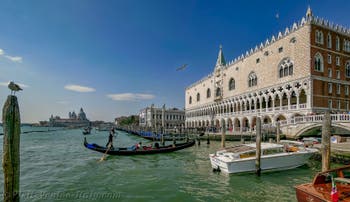
Doge's Palace in Venice in Italy The Doge's Palace in Venice had three main parts directly related to its three main functions:
1. - The Doge Residence
2. - The Palace of Justice
3. - The Communal Palace
The Doge's Palace, seat of power in Venice, brought together in one place all the powers: legislative, executive and judicial.
The Doge's Palace: a Geographically Organized Concentration of Powers
The various legislative, executive and judicial branches were housed in separate buildings, but all of which interacted.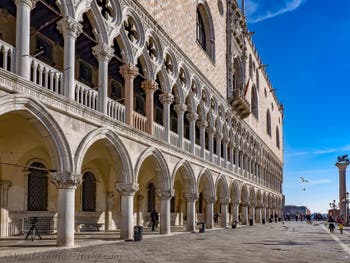
Doge's Palace in Venice in Italy - The residence of the doge was located on the side of the Rio di Palazzo o de la Canonica, the canal that spans the Bridge of Sighs.
- The seat of the government was positioned on the side of the St. Mark Basin.
- The Palace of Justice was on the side of the Piazzetta.
Each power occupied one side of the Doge's Palace while the fourth side corresponds to the Saint-Mark Basilica.
The Doge's Palace copy of King Solomon's Palace
The doge's apartments on the side of the Rio di Palazzo were adjacent to the seat of government on one side and the Basilica San Marco on the other.In this way, the Doge's Palace was inspired by the most famous seat of power in the Holy Land, namely King Solomon's Palace, which was also built against the temple of Jerusalem.
According to the First Book of Kings, King Solomon's Palace consisted of three parts: The Lebanon Forest Hall, the Judgment Hall, and King Solomon's residence.
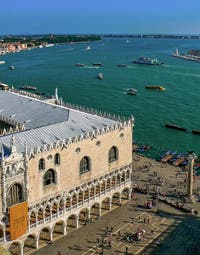
Doge's Palace We can therefore see that the Doge's Palace reproduces in its structure this positioning against the holy place.
But similarities are also numerous in terms of its proportions and volumes.
Thus, in the Bible, the Lebanon Forest Hall had identical volume proportions with those of the wing on the side of the Saint Mark Basin with a length-to-height ratio of three by one.
The facade of the Doge's Palace also reproduces that of the Palace of Solomon: three rows of windows topped by a wooden roof.
The doge's residence is located, always like King Solomon's, in a second courtyard after the portico.
As for the Council Chamber, the seat of the Venetian Parliament, its dimensions are two by one, while the biblical scripture’s state: "The length was a hundred cubits and the width fifty."
Also as in King Solomon's Palace, the Doge's Palace includes a Judgment Room which is identical to the other buildings of the palace.
The reference to King Solomon's palace is also recalled by the sculpture placed at the corner of the Doge's Palace, next to St. Mark's Basilica, which represents the "Judgment of Solomon".
Finally, the famous architect Hiram of Tyre, had positioned two great bronze pillars in front of the Palace of Solomon, which the Venetians reproduced with the two columns of Piazzetta San Marco topped by the two protectors of Venice: The Lion of St. Mark on one and Saint Theodore (the first protector saint of Venice before the repatriation of the body of the evangelist in Venice) on the other.
The Grand Council Hall of the Doge's Palace in Venice
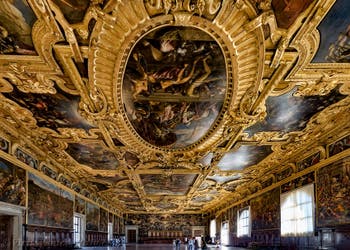
Grand Council Hall Doge's Palace The Grand Council Hall is 53 metres long, 25.92 metres wide and 10.2 metres high.
The Grand Council was the Venetian Parliament, the political structure that will have the greatest impact on the architectural evolution of the Ducal Palace over the centuries.
Originally the main hall of the Maggior Consiglio was located on the ground floor of the palace, at the eastern end of the south facade.
However, the number of members of this assembly, originally 400 members, increased to more than 1200 members after the measurement of the "Serrata" in 1297.
The original Grand Council Hall on the ground floor of the palace could not accommodate such a number of parliamentarians.
It should also be noted that the palace buildings were built around a courtyard whose function was also the recovery of rainwater with its own cistern.
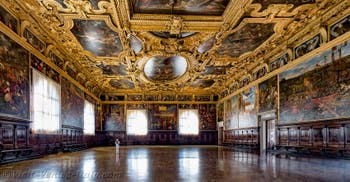
Grand Council Hall Doge's Palace Expansion of the Grand Council Chamber on the ground floor would therefore have forced the movement of this water tank.
After several decades of hesitation, it was decided in 1340 to build a new Grand Council Chamber, but this time on the first floor of the palace.
The entire south wing was therefore rebuilt to accommodate a Grand Council Chamber capable of responding to the increase in the number of parliamentarians.
The reconstruction of this wing and the new Grand Council Chamber was completed in 1365.
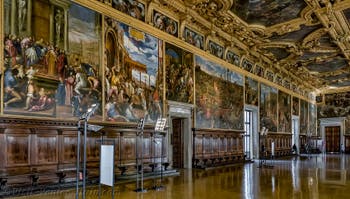
Grand Council Hall Doge's Palace The Grand Council Hall of the Doge's Palace is at the same time grandiose and magnificent.
Moreover, by an architectural effect, this room seems much larger than the building that contains it.
Its walls and ceilings are entirely covered with golden mouldings and paintings with warriors and religious themes, most of them evoking the greatness of Venice.
One of these paintings, "The Paradise" by Tintoretto, covers the entire width of the hall, where the doge and dignitaries sat at the assemblies of the parliament.
The Palace of Justice
Justice was represented in all its functions at the Ducal Palace, since not only did the Quarantia Civile (The Forty), the High Court of Appeal of the Republic, in the palace, there were prisons!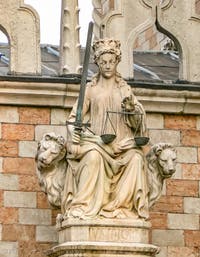
Justice Doge's Palace But with the increase in the power of the Republic of Venice over the centuries and the consequential increase in the need for space for institutions with an increasing number of members, it was decided to move prisons to the other side of the Rio di Palazzo from the beginning of the 1500s.
After numerous architectural works and changes, the prisons were permanently displaced around 1567, when a second phase of prison construction was undertaken across the Rio and completed in 1602 with the construction of the sinister Bridge of Sighs, which directly connected the Tribunal Hall to the prisons.
The Palace of Justice dominated the Piazzetta to the west and it was in 1422 that the decision to expand the palace to integrate the Palace of Justice was made.
In 1438 the new wing of the Palace of Justice was completed.
The facade is occupied by the beautiful loggias of the high gallery.
This gallery and its quadruple columns with their magnificent capitals carved with foliage, extend over the entire first floor.
It is also known that in 1494, semi-public hearings of the court were held under the arcades of the Ducal Palace.
Doge's Palace in Venice: The "Porta della Carta"
In translation, the papers door.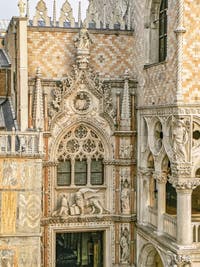
The Papers door This name comes from the fact that the notices were placed there, but it was also there, at the origin of the palace, that the scribes and archives were located.
It was first referred to as the "Golden Gate" because its sculptures were originally covered with gold.
This magnificent door overlooking the Piazzetta, right next to St. Mark's Basilica, is a work that contradicts the spirit of the Republic that prohibited any worship of personality on the part of its leaders.
The doge was there to serve the citizens and was not supposed to be a king.
However, the Doge Francesco Foscari, who built it, did not hesitate to be represented there personally, kneeling against the lion of St. Mark.
This precedent in the history of the Republic will then be resumed, since the way was now open, by other doges including Agostino Barbarigo whose effigy can be seen on the clock tower.
Doge Foscari wanted to move to posterity and thus made the Porta della Carta an impressive monument that could satisfy his vanity.
It was through this door that dignitaries and ambassadors of foreign countries who were officially received in Venice had to pass.
It was therefore appropriate to impress them with its beauty and symbols.
It was also through this door that the processions of the Signoria and the Doge began on festive days.
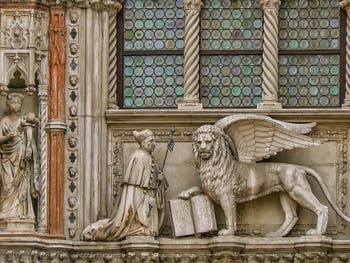
Doge Foscari Papers door Such a prestigious setting for the departure of these processions further reinforced the impression of power that the leaders of the Republic of Venice wanted to show to the people.
This paper door was made by Venetian stonemasons Zuanne and Bartolomeo Bon.
It was started in 1438 and completed in 1440, in just 18 months. This is one of the most beautiful examples of the Gothic Floral style.
A painting by Gentile Bellini shows us that this marble set was originally polychrome with paint and gold.
Saint Mark is represented twice, both under his human figure, in a bust in the central medallion, but also in his symbolic figure in the form of the lion, represented under the said medallion, with the Doge Foscari kneeling before him.
It should be noted that even if the doge is kneeling, he stands at the same time very straight, with his head being at the same height as that of the lion.
Doge Francesco Foscari was represented as almost equal to Saint Mark, a quasi-heresy in the Republic of Venice.
The Doge Foscari was known for its sumptuous expenses designed to establish the prestige of Venice and probably his own.
It should be noted that the Doge Francesco Foscari was obliged to abdicate on 29 September 1457 and that after his abdication the Grand Council will pass laws limiting the power of the Council of Ten.
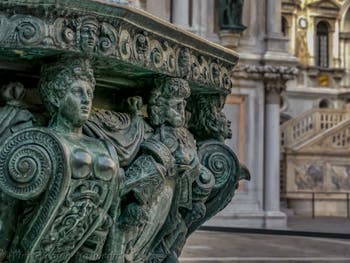
Well, Doge's Palace Courtyard This statue of the doge and the lion managed to escape destruction under Napoleonic occupation, during which most of the sculptures depicting the lion of St. Mark and all the elements that could represent the power of the former Republic of Venice were destroyed.
Napoleon had to be the one and only...
Fortunately moved before it can be destroyed, one can still see the original in the palace museum. The one you currently see on the Porte della Carta is a reproduction of the 20th century.
The four virtues are also represented on the gate della Carta: Strength, Temperance, Prudence and Charity.
The Porta della Carta is also dominated by an allegory of Justice, again a symbolic reminder of King Solomon's Palace.
The frame of the door is made of small lion heads, repetition of the symbol of Saint Mark the Evangelist.
The Doge's Palace in Venice: Sculptures
But the Doge's Palace is also remarkable for the hundreds of sculptures that make up it.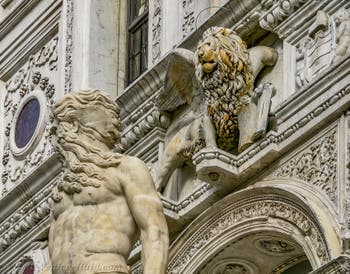
Neptune and Saint-Mark Lion Sculptures chosen very carefully for the symbols they represented.
There are two hierarchical orders of sculptures in the Ducal Palace.
First of all, the sculptures of the upper orders of the two angles of the facade overlooking the St. Mark's Basin which represent the archangels, the spiritual guides.
On the corner to the east, at the level of the Ponte de la Paglia overlooking the Rio de Palazzo o de Canonica, is the Archangel Raphael, the Archangel Protector of Travellers and Pilgrims.
On this sculpture he guides the young Tobias.
On the other side, to the West, is the statue of the Archangel Michael holding a sword drawn and symbolizing the struggle of good against evil and thus symbolizes the Republic of Venice against the infidels!
While at the level of the higher order are represented the spiritual guides, on the contrary, at the level of the lower order one can see sculptures symbolizing the weaknesses of men.
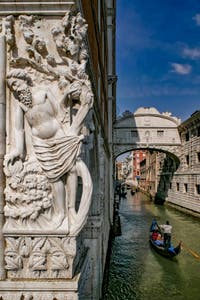
Noa's Drunkenness We see groups of sculptures representing "Noah's drunkenness" or the "Fall of Adam and Eve" on the west corner, a sculpture made by Antonio Rizzo in 1476.
On the other hand, on the corner next to the Porta della Carta, we can see the Judgment of Solomon, carved around 1430.
To the weaknesses of the first two sculptures is therefore symbolically attached Justice as a consequence of them.
The capitals of the entire portico from Ponte de la Paglia to Porta della Carta, on both outer sides along the Basin of St. Mark and Piazzetta, are full of allegorical figures.
You can see the virtues of Honesty, Humility, Abstinence, Chastity, Force, Liberality, Mercy, Temperance, Prudence, Justice, Zeal, Modesty or Patience.
But human weaknesses and vices are also represented: Envy, Vanity, Lie, Laziness, Greed, Greed, Injustice, Lust, Infidelity, Pride, Discord, Anger and Despair.
The virtues of the family, with its joys and sorrows, are also represented on these capitals, forming together with the previous sculptures a book of biblical and evangelical images.
Art Story Power | Tintoretto Paradise | Architecture | Staircases | Senate Collegio | Atrium
Doge's Palace Art Story | Location | Opening Hours Tickets | Authorizations
Back to Top of Page

